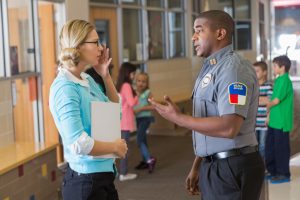
Active shooter planning should not be a one time thing but rather an ongoing process, especially when it comes to educational facilities. This process requires consistently updating plans and completing regular training to ensure that everyone knows their role in an active shooter situation. Especially considering the recent uptick in school shootings, now is the time to review and update all protocols.
Are You Accurately Identifying Active Shooter Threats?
Shooters have become more sophisticated in recent years. The internet is a double-edged sword. While it allows students to learn more, it also provides opportunities for shooters to plan their attacks better. Be aware that these incidents are almost never spontaneous. There are signs that an attack is imminent which—when recognized—can help prevent a deadly occurrence.
Security experts do not recommend creating a “shooter profile” as these can lead to false conclusions. Lessons learned from the past show us these perpetrators are diverse in appearance and motivation, which makes them unlikely to fit a simple profile. Instead of looking at profiles, school should implement monitoring procedures to include:
- Amnesty for reporting: Students and teachers should not be afraid to report when another student makes a threat or behaves in a way that’s concerning.
- Social media monitoring: In many mass shootings—both at schools and other locations—the perpetrator made clear and direct threats on social media channels both before and during the shooting.
- Escalation as needed: In the event of a threat, schools should get local law enforcement or private security involved as soon as possible.
How Fast Is Your Response Time?
Most casualties in an active shooter situation occur within the first 90 seconds of an attack. Meanwhile, the average response time for emergency services nationwide is three minutes. During the highest risk period, students and teachers have no backup. At this point, they have one of three options in dealing with the perpetrator: flight, fight or delay.
- Flight: Many schools use outdated “duck and cover” procedures as a cure-all, but these are entirely inappropriate for active shooter situations. This tactic, invented in the 1960s, was to avoid falling debris, not a direct strike from a projectile. Relying on this protocol is a dangerous mistake. The primary goal of students faced with a shooter should be getting away. Time spent finding a hiding place is time better spent escaping the area.
- Fight: The “fight” response can be a bit controversial, as the last thing you want is your students in the line of fire. However, when this is the last resort, you want to make sure the person fighting the shooter has the highest potential for success. Schools should implement evacuation plans based on this, ensuring the first to leave are the smallest and youngest students, while the last to go are teachers and other adults.
- Delay: Delaying the perpetrator is the most effective way to reduce loss of life. Simple updates like automatic lockdown to restrict the shooter’s movements have saved lives. Examples of this include the use of metal detectors to keep weapons off campus, and 3M security glass and metal doors to prevent shooters from firing their way in. Also, mass notification systems and shooter detection technology can be used to notify students and personnel of the incident as soon as possible, giving them the time they need to escape.
How Strong Is Your Outside Support?
The average response time for 911 services may be three minutes, but that might not always be the case for more rurals schools. What’s more, it can take over an hour for a scene to be called “cold,” allowing EMS to enter.
The only way your school will know this vital information is with regular drills. Test your complete plan and collaborate with first responders. Have specific active shooter drills as often as you have fire drills, if not more often.
These drills should also include the regular testing of your security systems. Metal detectors, cameras, critical communications systems and access control should work seamlessly with shooter detection technology to allow you to notify authorities immediately of an incident. These security features can even have a deterrent effect, as school shooters often look for the path of least resistance when they plan for an attack.
These attackers become more sophisticated every day, so your school’s security plan needs to match pace. Training, technology and outside collaboration must happen regularly for the best active shooter preparation.
This article was developed with the help of Ryan Searles, Vice President of Risk Management of The Texas Group Inc.
At 3Sixty Integrated, we create fully integrated security systems including access control, critical communications, and surveillance which can work seamlessly with active shooter detection systems. To ensure your technology is best prepared to support your staff and students in the event of an attack, call (210) 545-1770 or fill out our contact form.

